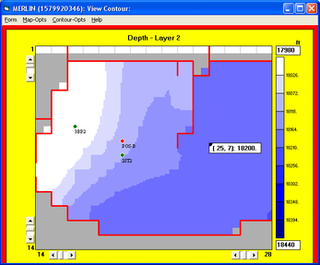
Db2 is a family of data management products, including database servers, developed by IBM. It initially supported the relational model, but was extended to support object–relational features and non-relational structures like JSON and XML. The brand name was originally styled as DB2 until 2017, when it changed to its present form.
Business intelligence (BI) consists of strategies and technologies used by enterprises for the data analysis and management of business information. Common functions of BI technologies include reporting, online analytical processing, analytics, dashboard development, data mining, process mining, complex event processing, business performance management, benchmarking, text mining, predictive analytics, and prescriptive analytics.

Decision theory is a branch of applied probability theory and analytic philosophy concerned with the theory of making decisions based on assigning probabilities to various factors and assigning numerical consequences to the outcome.

Analytics is the systematic computational analysis of data or statistics. It is used for the discovery, interpretation, and communication of meaningful patterns in data. It also entails applying data patterns toward effective decision-making. It can be valuable in areas rich with recorded information; analytics relies on the simultaneous application of statistics, computer programming, and operations research to quantify performance.
Unstructured data is information that either does not have a pre-defined data model or is not organized in a pre-defined manner. Unstructured information is typically text-heavy, but may contain data such as dates, numbers, and facts as well. This results in irregularities and ambiguities that make it difficult to understand using traditional programs as compared to data stored in fielded form in databases or annotated in documents.
Predictive analytics is a form of business analytics applying machine learning to generate a predictive model for certain business applications. As such, it encompasses a variety of statistical techniques from predictive modeling and machine learning that analyze current and historical facts to make predictions about future or otherwise unknown events. It represents a major subset of machine learning applications; in some contexts, it is synonymous with machine learning.

Reservoir simulation is an area of reservoir engineering in which computer models are used to predict the flow of fluids through porous media.
Customer attrition, also known as customer churn, customer turnover, or customer defection, is the loss of clients or customers.
Oracle Data Mining (ODM) is an option of Oracle Database Enterprise Edition. It contains several data mining and data analysis algorithms for classification, prediction, regression, associations, feature selection, anomaly detection, feature extraction, and specialized analytics. It provides means for the creation, management and operational deployment of data mining models inside the database environment.
Business analytics (BA) refers to the skills, technologies, and practices for iterative exploration and investigation of past business performance to gain insight and drive business planning. Business analytics focuses on developing new insights and understanding of business performance based on data and statistical methods. In contrast, business intelligence traditionally focuses on using a consistent set of metrics to both measure past performance and guide business planning. In other words, business intelligence focusses on description, while business analytics focusses on prediction and prescription.

Analytical skill is the ability to deconstruct information into smaller categories in order to draw conclusions. Analytical skill consists of categories that include logical reasoning, critical thinking, communication, research, data analysis and creativity. Analytical skill is taught in contemporary education with the intention of fostering the appropriate practises for future professions. The professions that adopt analytical skill include educational institutions, public institutions, community organisations and industry.
Pricing science is the application of social and business science methods to the problem of setting prices. Methods include economic modeling, statistics, econometrics, mathematical programming. This discipline had its origins in the development of yield management in the airline industry in the 1980s, and has since spread to many other sectors and pricing contexts, including yield management in other travel industry sectors, media, retail, manufacturing and distribution.

Big data primarily refers to data sets that are too large or complex to be dealt with by traditional data-processing application software. Data with many entries (rows) offer greater statistical power, while data with higher complexity may lead to a higher false discovery rate. Though used sometimes loosely partly due to a lack of formal definition, the best interpretation is that it is a large body of information that cannot be comprehended when used in small amounts only.
AIMMS is a prescriptive analytics software company with offices in the Netherlands, United States and Singapore.
In marketing, attribution, also known as multi-touch attribution, is the identification of a set of user actions that contribute to a desired outcome, and then the assignment of a value to each of these events. Marketing attribution provides a level of understanding of what combination of events in what particular order influence individuals to engage in a desired behavior, typically referred to as a conversion.
In the fields of Information Technology (IT) and Systems Management, IT operations analytics (ITOA) is an approach or method to retrieve, analyze, and report data for IT operations. ITOA may apply big data analytics to large datasets to produce business insights. In 2014, Gartner predicted its use might increase revenue or reduce costs. By 2017, it predicted that 15% of enterprises will use IT operations analytics technologies.
Neural Designer is a software tool for machine learning based on neural networks, a main area of artificial intelligence research, and contains a graphical user interface which simplifies data entry and interpretation of results.
An intelligence engine is a type of enterprise information management that combines business rule management, predictive, and prescriptive analytics to form a unified information access platform that provides real-time intelligence through search technologies, dashboards and/or existing business infrastructure. Intelligence Engines are process and/or business problem specific, resulting in industry and/or function-specific marketing trademarks associated with them. They can be differentiated from enterprise resource planning (ERP) software in that intelligence engines include organization-level business rules and proactive decision management functionality.
Geographic analytics is an analytical approach to strategic management and data analytics to make geographic decisions efficiently. Examples of such decisions are choosing the location for a warehouse or planning the regions for a marketing campaign. Data, information and framing conditions are visualized on maps to derive recommendations for action.









